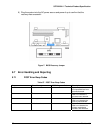
SE7221BK1-E Technical Product Specification
53
Run command afuefi [/n] [/p[b][n][c]] <ROM filename> to perform the update.
The afuXXX utilities format and usage:
afuXXX /i<ROM filename> [/n] [/p[b][n][c]] [/r<registry_path>] [/s] [/k] [/q] [/h]
/n - don't check ROM ID
/pbnc -
b - Program Boot Block
n - Program NVRAM
c - Destroy System CMOS
/r - registry path to store result of operation (only for Windows version)
/k - Program non-critical block only
/s - leave signature in BIOS
/q - silent execution
/h - print help
9.6.2 Flash Architecture and Flash Update Utility
The flash ROM contains system initialization routines, the BIOS Setup Utility, and runtime
support routines. The exact layout is subject to change, as determined by Intel. A 64 KB user
block is available for user ROM code or custom logos. The flash ROM also contains initialization
code in compressed form for on-board peripherals, like SCSI, NIC and video controllers. The
flash ROM also contains support for the Rolling single boot BIOS update feature.
The complete ROM is visible, starting at physical address 4 GB minus the size of the flash ROM
device. The Flash Memory Update utility loads the BIOS image minus the recovery block to the
secondary flash partition, and notifies the BIOS that this image should be used on the next
system re-boot. Because of shadowing, none of the flash blocks are visible at the aliased
addresses below 1 MB.
9.6.3 Rolling BIOS and On-line updates
The Online Update nomenclature refers to the ability to update the BIOS while the server is
online, in operation, as opposed to having to put the server out of operation while doing a BIOS
update. The Rolling BIOS nomenclature refers to the capability for having two copies of BIOS,
viz. the one in use, and the other to which an updated BIOS version can be written. When
ready, the system can roll forward to the new BIOS. In case of a failure with the new version,
the system can roll back to the previous version.
While the exact nature of hardware changes for the support of on-line update / rolling BIOS are
out of scope of this document, BIOS relies on specialized hardware and additional flash space
for this. Flash is divided into two partitions, viz. primary and secondary. The active partition
from which the system boots shall be referred to as the primary partition. The AMI FLASH
update suite and Intel On-line updates preserve the existing BIOS image on the primary
partition. BIOS updates are diverted to the secondary partition. After the update, a notification
flag will be set. During the subsequent boot following BIOS update, system will continue to
attempt to boot from primary BIOS partition. On determining that a BIOS update occurred in the
previous boot, system will attempt to boot the new BIOS. If a failure happens, specialized
hardware will switch back to the BIOS on the other partition, thus affecting a “Roll Back”.


















